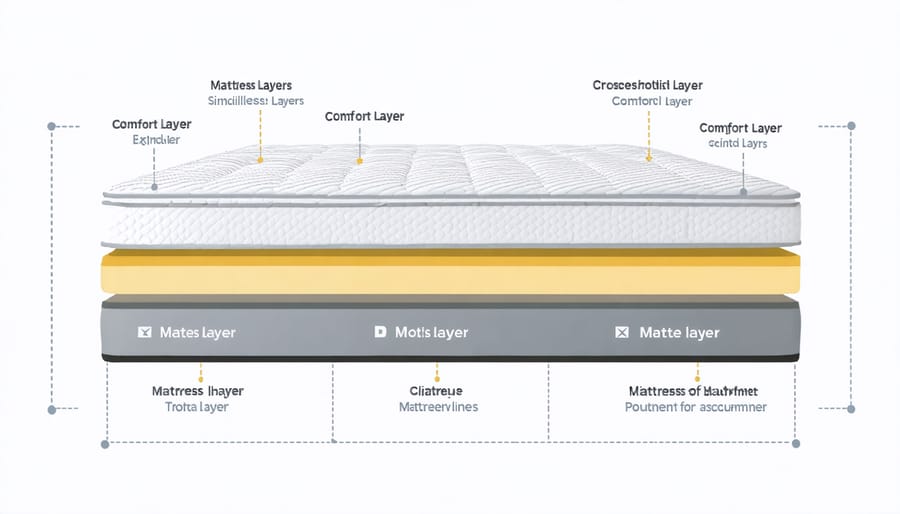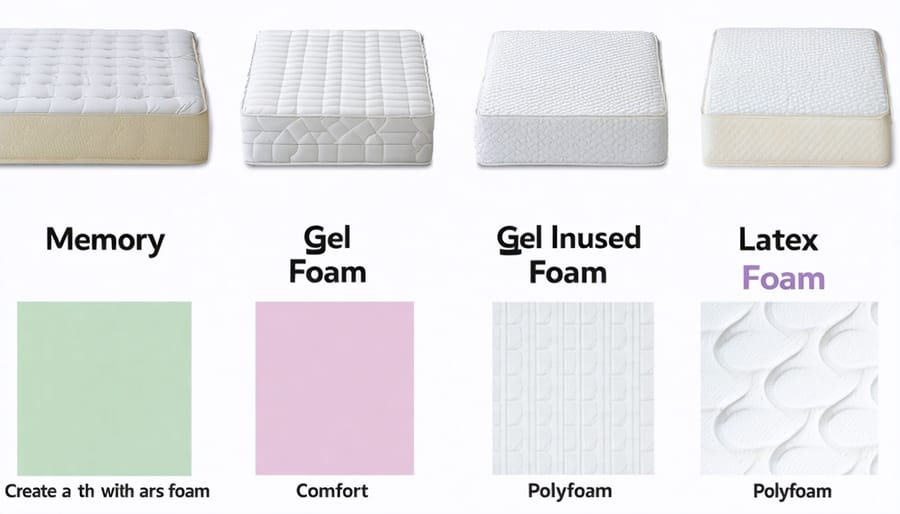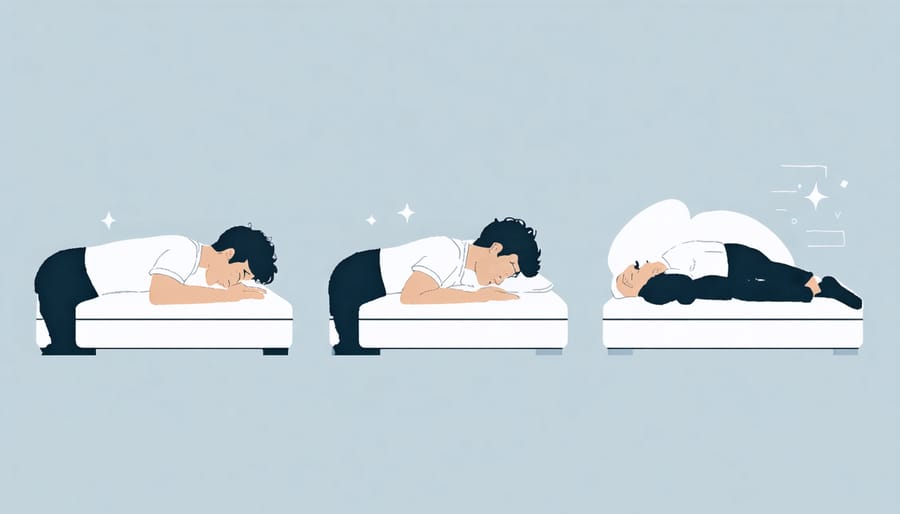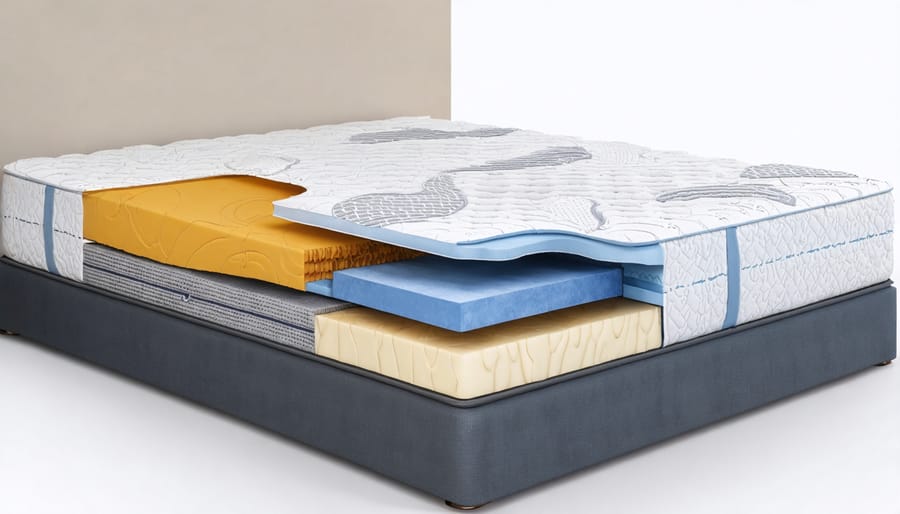Choose your mattress comfort layers carefully – they directly impact spinal alignment, pressure relief, and your ability to create a quality sleep environment. These crucial top layers of your mattress determine how your body interacts with the support core beneath, affecting everything from temperature regulation to motion isolation. Memory foam offers deep pressure relief and body-conforming properties, while latex provides natural bounce and cooling. Premium comfort layers combine multiple materials in strategic zones, delivering targeted support where your body needs it most. Understanding these components helps you select a mattress that addresses your specific sleep needs, whether you’re a side sleeper requiring extra shoulder cushioning or a back sleeper needing firmer lumbar support.
Understanding Mattress Comfort Layers
What Are Comfort Layers?
Comfort layers are the uppermost sections of a mattress that directly interact with your body during sleep. These specialized layers sit above the support core and typically consist of materials like memory foam, latex, or various types of polyfoam. Their primary purpose is to provide pressure relief and create a comfortable sleeping surface that promotes proper spinal alignment.
Think of comfort layers as the cushioning that cradles your body’s pressure points, such as your shoulders, hips, and knees. The thickness of these layers can range from 2 to 4 inches in basic mattresses to over 6 inches in luxury models. Each layer serves a specific purpose, with some focusing on temperature regulation, others on motion isolation, and still others on providing that initial soft feel when you first lie down.
The quality and composition of comfort layers significantly influence how your mattress feels and performs, making them crucial for achieving restful sleep.

How Comfort Layers Affect Sleep
Comfort layers play a vital role in promoting healthy sleep by providing targeted support and pressure relief to your body. When you lie down, these layers work to distribute your body weight evenly, helping to prevent pressure points that can cause discomfort and disrupted sleep. The right comfort layer allows your shoulders and hips to sink in slightly while maintaining proper spinal alignment.
Research shows that pressure relief from quality comfort layers can reduce nighttime tossing and turning by up to 30%. This increased sleep stability helps you spend more time in deep, restorative sleep phases. Additionally, comfort layers with temperature-regulating properties help maintain an optimal sleeping temperature between 18-22°C, which studies have linked to better sleep quality.
The thickness and density of comfort layers also affect how well they support different sleeping positions. Side sleepers typically benefit from thicker, softer comfort layers, while back and stomach sleepers often sleep better with slightly firmer options that prevent excessive sinking.

Common Comfort Layer Materials
Memory Foam
Memory foam comfort layers respond to your body heat and weight, creating a personalized sleeping surface that gently cradles your pressure points. This temperature-sensitive material slowly conforms to your body shape, providing excellent pressure relief and reducing tossing and turning throughout the night. The foam’s ability to isolate motion makes it particularly beneficial for couples, as movement from one partner won’t disturb the other.
The material’s supportive properties help maintain proper spinal alignment, which can reduce morning stiffness and back pain. Memory foam comfort layers are available in various densities and thicknesses, with higher-density foams typically offering better durability and support. While traditional memory foam can retain heat, many modern versions incorporate cooling technologies like gel infusion or open-cell structures to help regulate temperature for more comfortable sleep.
Latex
Latex comfort layers offer unique benefits for sleep quality and comfort. Available in both natural and synthetic forms, latex provides exceptional pressure relief while maintaining proper spinal alignment. Natural latex, harvested from rubber trees, is particularly appealing for its eco-friendly and hypoallergenic properties. It naturally resists dust mites and mold, making it an excellent choice for allergy sufferers.
The material offers impressive durability, typically lasting longer than other comfort layer materials. It provides a responsive feel that combines support with gentle contouring, helping reduce pressure points without the “sinking” sensation some sleepers dislike. Synthetic latex shares many of these qualities while being more affordable.
Both types offer good temperature regulation, as latex’s open-cell structure allows air to flow freely, helping maintain a comfortable sleeping temperature throughout the night.
Gel-Infused Foams
Gel-infused foams represent an innovative solution for temperature regulation in mattress comfort layers. These materials combine the pressure-relieving properties of traditional memory foam with cooling gel particles or beads that help dissipate body heat. The gel actively works to prevent heat buildup by absorbing and distributing warmth throughout the foam layer, creating a more comfortable sleeping environment.
These specialized foams offer medium to medium-firm support while maintaining responsiveness to body movement. The gel components help reduce the “sinking” feeling often associated with regular memory foam, making it easier to change positions during sleep. This technology is particularly beneficial for people who tend to sleep hot or live in warmer climates.
The cooling properties typically last throughout the mattress’s lifespan, though effectiveness may gradually decrease over time. When selecting a gel-infused foam mattress, look for options with even gel distribution and adequate density for optimal support and cooling benefits.
Polyfoam
Polyfoam represents one of the most common comfort layer materials in modern mattresses, offering a balanced combination of support and pressure relief. This versatile material comes in various densities, from soft to firm, making it suitable for different sleep preferences. High-quality polyfoam provides good body contouring and helps distribute weight evenly across the mattress surface, reducing pressure points that can cause discomfort during sleep.
While traditional polyfoam is generally more affordable than memory foam, premium versions offer enhanced durability and better temperature regulation. The open-cell structure allows for better airflow compared to older foam technologies, helping maintain a comfortable sleeping temperature. For budget-conscious shoppers, polyfoam comfort layers present a practical option that delivers reliable comfort without compromising on essential sleep support features.
Choosing the Right Comfort Layer
Sleep Position Considerations
Your sleeping position considerations play a crucial role in determining the ideal comfort layer for your mattress. Side sleepers typically benefit from softer, thicker comfort layers that allow their shoulders and hips to sink in while maintaining spinal alignment. Memory foam or latex layers between 2-4 inches thick often work well for this position.
Back sleepers generally need medium-firm comfort layers that provide enough cushioning while preventing excessive sinking. A combination of memory foam and latex, or high-density polyfoam around 2-3 inches thick, usually offers the right balance of support and comfort.
Stomach sleepers require firmer, thinner comfort layers to prevent their midsection from sinking too deeply, which could cause lower back strain. A thin layer of firm latex or high-density foam, typically 1-2 inches thick, works best for maintaining proper spinal alignment in this position.
For combination sleepers who change positions throughout the night, medium-feel comfort layers with moderate thickness (2-3 inches) and quick response times, such as latex or responsive polyfoam, offer the best versatility.

Health and Physical Needs
The right comfort layer can significantly impact various health conditions and accommodate different body types. For those with back pain, medium-firm comfort layers provide essential support while relieving pressure points. Side sleepers with hip or shoulder pain benefit from memory foam or latex layers that offer targeted cushioning in these sensitive areas.
Individuals with arthritis or fibromyalgia often find relief with softer comfort layers that reduce joint pressure. However, those carrying extra weight typically need denser comfort layers to prevent excessive sinking and maintain proper spinal alignment. Memory foam or latex layers with higher density ratings are particularly effective for heavier individuals.
Temperature-sensitive sleepers should consider gel-infused or open-cell comfort layers that promote better airflow and regulate body temperature. People with allergies may want to opt for natural latex or hypoallergenic foam layers that resist dust mites and other allergens.
Regardless of specific health needs, the comfort layer should maintain its supportive properties while adapting to your body’s unique contours, promoting healthy sleep posture and reducing morning stiffness.
Temperature Sensitivity
Different comfort layer materials respond uniquely to body heat, making temperature regulation during sleep an important consideration. Memory foam tends to retain heat, which some people find cozy during cold Canadian winters, while others may find it too warm. Latex and gel-infused foams offer better cooling properties, making them ideal for those who sleep hot or experience night sweats. Traditional polyfoam strikes a middle ground, while newer materials like phase-change technology actively work to maintain optimal sleeping temperatures. Consider your natural sleeping temperature and local climate when selecting a comfort layer material to ensure the most comfortable sleep experience throughout the year.
Maintaining Your Comfort Layer
Proper maintenance of your mattress’s comfort layer can significantly extend its lifespan and maintain its supportive properties. Rotate your mattress every three to six months to ensure even wear across the comfort layer. This practice prevents permanent body impressions and helps maintain consistent support throughout the sleeping surface.
Use a high-quality mattress protector to shield the comfort layer from spills, sweat, and other contaminants that can break down the materials over time. When cleaning, avoid harsh chemicals that might damage the comfort materials. Instead, spot clean with mild soap and water, allowing the area to dry completely before making the bed.
Keep your bedroom’s humidity levels between 30-50% to prevent moisture buildup in the comfort layer, which can lead to material degradation and potential mold growth. Avoid sitting on the same spot of the bed for extended periods, as this can cause uneven compression of the comfort materials.
If you notice any significant changes in comfort or support, such as deep impressions or uneven surfaces, address these issues promptly. Some comfort layers, particularly those made with memory foam or latex, may benefit from occasional “airing out” – remove all bedding for a few hours to allow the materials to breathe and recover their original properties.
Following these maintenance practices will help ensure your comfort layer continues to provide optimal support and comfort for years to come.
Choosing the right comfort layer for your mattress is a crucial decision that directly impacts your sleep quality and overall well-being. By understanding the different materials available, from memory foam to latex and polyfoam, you can better select a comfort layer that meets your specific needs. Consider factors like your sleeping position, body weight, temperature sensitivity, and any health conditions that may affect your sleep. Remember that the best comfort layer balances support and cushioning while addressing your personal preferences. Take time to research, test different options when possible, and invest in quality materials that will maintain their properties over time. With the right comfort layer, you can create an optimal sleep environment that promotes restful nights and healthier days.

